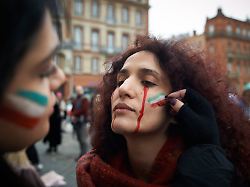Tehran intensifies repression
First anniversary of Mahsa Amini’s death is approaching
9/4/2023 8:49 am
“The cruelty of the Iranian authorities knows no bounds,” laments Amnesty International. Almost a year after Amini’s violent death, protests continue, but the security forces’ crackdown has intensified. And the West is watching.
Before the first anniversary of the death of the young Kurd Mahsa Amini, the authorities in Iran are again intensifying the repression. According to activists, arrests of government critics have recently increased. The government wants to “spread fear among the population” before the anniversary and deter new protests, according to the head of the New York-based Center for Human Rights in Iran (CHRI), Hadi Ghaemi.
22-year-old Amini died on September 16 after being arrested by the vice squad in Tehran. She is said to have violated the strict rules for wearing the Islamic headscarf. The authorities cited long-standing health problems as the cause of the young woman’s death. The opposition, however, accused Amini of having been beaten in police custody. Her death sparked nationwide protests of unprecedented proportions against the leadership in Tehran. The authorities reacted with great severity.
Hundreds of people were killed during the protests, including dozens of members of the security forces. Thousands of people have been arrested in connection with the protests. The demonstrations broke taboos and thus touched on the ideological foundations of the Islamic Republic founded in 1979: During the protests, slogans were chanted against the spiritual leader Ayatollah Ali Khamenei, and women openly roamed the streets without the prescribed headgear.
Apart from a few sporadic actions, however, the protests have now died down. Activists living in exile see the reason in the brutal actions of the security forces and authorities. Attempts are being made to intimidate people with arrests and death sentences.
Most recently, popular pop musician Mehdi Yarrahi was taken into custody. The singer had recently released a song with an accompanying video in which he questioned the headscarf requirement.
The cruelty of the Iranian authorities knows no bounds
According to a report by the US-based Human Rights Activists News Agency (HRANA), 11 women’s rights activists were also arrested in August in the northern province of Gilan, where protests had been particularly fierce last year. Further arrests were recently reported from the region in western Iran, which is mostly inhabited by Kurds – Amini’s homeland and the scene of the first protests a year ago. According to the Hengaw organization, one of its members was arrested in Amini’s hometown of Sakes and taken to an unknown location.
Amnesty International said that relatives of killed protesters have been victims of arbitrariness and repression. According to a report by the human rights organization, a number of families of those killed have been subjected to abusive interrogation, arbitrarily arrested, prosecuted and sentenced under unfair conditions in recent months.
“The cruelty of the Iranian authorities knows no bounds,” said Diana Eltahawy, Amnesty’s Deputy Regional Director for the Middle East. She accused the Iranian authorities of a “sinister attempt” to “cover up their crimes”.
In a separate report, Amnesty denounced the authorities’ increased use of patrols and cameras against unveiled women. However, images circulating on online networks testify to the undiminished courage of many women who are still defying the headscarf regulation a year after Amini’s death.
The Norway-based organization Iran Human Rights (IHR) said that 486 people were executed in Iran this year to “foment fear in society and prevent further protests”. While seven men were sentenced to death in connection with the protests, most of those hanged were officially executed for drug trafficking and murder. They are “cheap victims of the Islamic Republic’s killing machine,” explained IHR.
